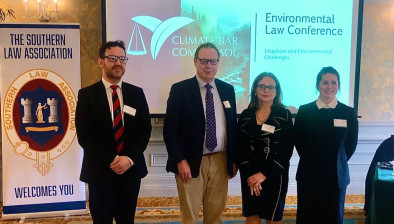Supreme Court: Environmental challenge to Glanbia cheese factory dismissed

The Supreme Court has dismissed an appeal brought by An Taisce against the grant of permission for a major cheese factory in Slieverue, Co Kilkenny. It was argued by the appellant that the new factory would consume 450 million litres of milk per year, and that the environmental impact of this consumption had to be assessed by An Bord Pleanála under Article 3(1) of the Environmental Impact Assessment Directive 2011.

About this case:
- Citation:[2022] IESC 8
- Judgment:
- Court:Supreme Court
- Judge:Mr Justice Gerard Hogan
However, the Supreme Court ruled that the upstream consequences of the supply chain for the new factory was not a matter which the Board was required to consider under environmental law. It was stated that An Taisce’s interpretation would leave “hardly any limits but the sky” to potential areas of review when making planning decisions.
Background
In June 2020, the Planning Board granted an application to Kilkenny Cheese Limited to construct a cheese factory in Slieverue. The development was a joint venture between Glanbia and Royal-a-Ware, a Dutch company. The project was designed to facilitate a move away from producing cheese for the UK market and instead supplying cheese to the continental European market.
The factory was projected to require 450 million litres of milk per year, which was estimated to represent 4.5 percent of the national milk supply in 2025. Approximately 20 percent of the milk that the developer intended to use was already in circulation and would be redirected from UK destinations to the Slieverue factory. The remaining milk would be produced from additional capacity in Glanbia’s 4,500 farms.
The appellant, An Taisce, opposed the initial grant of permission by Kilkenny County Council in November 2019 and appealed to the Planning Board. It was argued that the milk production required to supply the factory would increase Ireland’s environmental emissions and prevent the State from meeting its climate targets.
The Board’s inspector produced a report in favour of the planning permission in June 2020 and the planning permission was confirmed by the Board later that month. The appellant took judicial review proceedings seeking to quash the decision.
The main submission from the appellant was that the Board had failed to conduct an adequate environmental impact assessment of the factory’s indirect impact on milk production in the State. In this regard, the appellant relied on Article 3(1) of the EIA Regulation, which stated that every EIA should assess “the direct and indirect significant effects of a project” on a range of matters such as land, soil, water, air and climate.
Furthermore, the appellant raised grounds which had not been raised in the planning process, being that the Board had failed to conduct an adequate assessment under the Habitats Directive and had acted in breach of the Water Framework Directive by granting permission of a project that would result in pollution of the River Suir.
The Board submitted that it was not under an obligation to assess the environmental impact on off-site milk production on the basis that it was too remote. However, even if it was under an obligation, the Board submitted that it had in fact discharged that obligation in the present case.
The High Court refused to grant the application for judicial review and also refused to certify any points of appeal to the Court of Appeal. In September 2021, the appellant obtained leave to appeal directly to the Supreme Court.
Supreme Court
Delivering judgment in the case, Mr Justice Gerard Hogan began by outlining the findings of fact made by the Board. The court considered the submissions of the parties to the Board and the Inspector’s report. Ultimately, the Inspector determined that, although the production of 450 million litres of would have indirect effects on the environment, these effects were already known and measured in the existing Government policy on emissions in the dairy sector.
The Board had accepted that most of the milk was either already in circulation or would be produced from increased capacity from Glanbia’s 4,500 farms. There was also a projected 4.5 per cent increase in the national herd by 2025 which would therefore account for the new milk, the Board said.
The court held that the Board was entitled to make the finding that the factory’s requirements would be met by the existing milk pool. However, it was noted that the overall demand for milk in the State was likely to go up. For example, the 20 per cent of milk redirected from UK markets would likely be filled by another producer.
The court moved to consider the meaning of Article 3(1) and offered two interpretations. First, the obligation to assess indirect effects could be read in an open-ended fashion and that any effects on the environment have to be considered. The second interpretation was that indirect effects must only be those which the development itself has on the environment.
The court considered the case law, including R.(Finch) v. Surrey County Council [2020] EWHC 3566 (Admin) and held that assessing the upstream or downstream consequences of a development was too remote and impractical. The court queried where an assessment would end, using examples such as whether factors such as lorry transport and plastic production had to be considered.
In the present case, it was “simply not feasible” to assess the impact of the factory on the 4,500 Glanbia farms. The court held that the open-ended test would barely limit the range of possible inquiries into such developments. For these reasons, the court adopted the more limited interpretation of Article 3(1) where only the effects of the development itself had to be considered by the Board.
Next, Mr Justice Hogan turned to consider whether an appropriate assessment had been carried out by the Board under Article 6(3) of the Habitats Directive. The court considered Sweetman (Case C-258/11) and Kelly v. An Bord Pleanála [2014] IEHC 400 and held that all reasonable scientific doubt about potential effects on a site had to be excluded by the Board.
The court outlined the appellant’s grounds of objection to the appropriate assessment, which required the court to consider the material placed before the Board at the time of its decision. The court was satisfied that the information was satisfactory to comply with the case law and remove scientific doubt about the development. Accordingly, the objections to the appropriate assessment were not upheld.
Conclusions
The court dismissed the appeal, although it was accepted that An Taisce had raised important points in the case. As such, the provisional view of the court was that each side bore their own costs.










